Farouk Gulsara's Blog, page 110
May 15, 2019
Beds are burning!
The Boy in Striped Pyjamas (2008)
 When we were very young, we used to think the world of our parents. They were the strongest, the brainiest and the smartest. Somehow, they knew everything and could do no wrong. Slowly, we grew older and started hating their guts. We view their world viewpoints as archaic and promise never to be like them. We abhor their un-PC statements and over-glorification of the good old days.
When we were very young, we used to think the world of our parents. They were the strongest, the brainiest and the smartest. Somehow, they knew everything and could do no wrong. Slowly, we grew older and started hating their guts. We view their world viewpoints as archaic and promise never to be like them. We abhor their un-PC statements and over-glorification of the good old days.
And yet with the passage of time and dents from the School of Hard Knocks, it soon dawns upon us their wisdom and ability to juggle so many things despite their limited resources.
This film is historical fiction from the point of view of Bruno, an 8-year old son of Army Lieutenant, in Nazi Germany. His father is stationed in the countryside to take charge of a concentration camp. The young boy befriends Shmuel, an 8-years old Jewish inmate, on the other side of the concentration camp. Bruno burrows himself into the camp to help Schmuel locate his missing father. Little do they know that their little adventure ends up in the gas chamber that Bruno's father has been commissioned to run. In the cruel twist of fate, Bruno (and Schmuel) succumb to the Zyklon B poisoning.
In a poetic way, the film questions whether the death of an enemy is any less painful than one of our own flesh and bone? Can we sing when other's beds are burning?
Childhood is measured out by sounds and smells and sights before the dark hour of reason grows. John Betjeman.

This work is licensed under a Creative Commons Attribution 4.0 International License.
http://asok22.wix.com/real-lesson
http://.facebook.com/farouk.gulsara
www.riflerangeboy.com
This work is licensed under a Creative Commons Attribution 4.0 International License.

 When we were very young, we used to think the world of our parents. They were the strongest, the brainiest and the smartest. Somehow, they knew everything and could do no wrong. Slowly, we grew older and started hating their guts. We view their world viewpoints as archaic and promise never to be like them. We abhor their un-PC statements and over-glorification of the good old days.
When we were very young, we used to think the world of our parents. They were the strongest, the brainiest and the smartest. Somehow, they knew everything and could do no wrong. Slowly, we grew older and started hating their guts. We view their world viewpoints as archaic and promise never to be like them. We abhor their un-PC statements and over-glorification of the good old days.And yet with the passage of time and dents from the School of Hard Knocks, it soon dawns upon us their wisdom and ability to juggle so many things despite their limited resources.
This film is historical fiction from the point of view of Bruno, an 8-year old son of Army Lieutenant, in Nazi Germany. His father is stationed in the countryside to take charge of a concentration camp. The young boy befriends Shmuel, an 8-years old Jewish inmate, on the other side of the concentration camp. Bruno burrows himself into the camp to help Schmuel locate his missing father. Little do they know that their little adventure ends up in the gas chamber that Bruno's father has been commissioned to run. In the cruel twist of fate, Bruno (and Schmuel) succumb to the Zyklon B poisoning.
In a poetic way, the film questions whether the death of an enemy is any less painful than one of our own flesh and bone? Can we sing when other's beds are burning?
Childhood is measured out by sounds and smells and sights before the dark hour of reason grows. John Betjeman.

This work is licensed under a Creative Commons Attribution 4.0 International License.
http://asok22.wix.com/real-lesson
http://.facebook.com/farouk.gulsara
www.riflerangeboy.com
This work is licensed under a Creative Commons Attribution 4.0 International License.

Published on May 15, 2019 09:30
May 13, 2019
Out of Africa?

The world has been under the impression that Africa was a dark continent, that it was primitive. Scholars always refrained from using the words 'philosophy' and 'wisdom' in the same sentence when it came to Africa. People tend to look at this vast continent with scorn as a place where its natives delved in black magic and the belief in the occult practices.
The truth is far from that.
As far as philosophy is concerned, Africa can be divided into two geographical locations - North Africa and Sub-Saharan Africa. The contributions by the North African dwellers are said to be predating the Egyptian dynastic era. With the spread of the Abrahamic religions to this area, many thinkers gifted their input into Jewish, Christian and Islamic epistemologies. Offhand, philosophers such as Augustine of Hippo, Ibn Sab'in, Ibn Rushd (Averroes), and Ibn Bajjah come to mind.
The Sub Saharan region, however, is more complicated. With 3,000 over tribes occupying that area with no written language or sacred text, analysis becomes problematic. The similarity is there, nevertheless, on the concept of time and personhood. If they are any indications, oral history and proverbs that had passed from generations to generations may give insight into their general outlook of life.
John Samuel Mbiti, a professor and a parish minister, through his research into African oral traditions, has challenged the long-held Christian assumption that African religious ideas were 'demonic and anti-Christian'.
Exciting concepts that I gathered after listening to Professor Peter Adamson's 'History of Africana Philosophy' involve the idea of God and time.
 Sankofa symbol - Twi language, means 'reach back and get it'
Sankofa symbol - Twi language, means 'reach back and get it'In these cultures, time is categorised into the past, present and immediate future. There is no future because the future is actually only in memory as we move along in time. Sasha (now) slowly moves along to become the long forgotten past (Zamani). Sasha denotes spirits remembered by those living. As the present dies, they would eventually go into the hidden history, Zamani, where nobody present remembers. So, in a way, they are telling that time moves in a loop. We live for the future, but in actual fact, we get pushed into the past. The spirits only leave the mortal body but are forever present in the spiritual world. There is no distinction between the physical and spiritual world. The physical body decays, but the spirit moves to another existence.
This pretty much resonates with David Eagleman's 'Three Stages of Death': the first is when the body ceases to function. The second is when the body is consigned to the grave. The third is that moment, sometime in the future, when your name is spoken for the last time.
The African concept of God is closely linked to their dependence on Nature and land. A non-anthropomorphic omnipotent, omnipresent and omniscient Supreme Being that exerts His powers via Nature and in phenomena beyond human control.
http://www.newworldencyclopedia.org/entry/African_philosophy

This work is licensed under a Creative Commons Attribution 4.0 International License.
 http://asok22.wix.com/real-lesson
http://asok22.wix.com/real-lessonhttp://.facebook.com/farouk.gulsara
www.riflerangeboy.com
This work is licensed under a Creative Commons Attribution 4.0 International License.

Published on May 13, 2019 09:30
May 11, 2019
The hand that rocks the cradle and the world!
Manikarnika (2019)
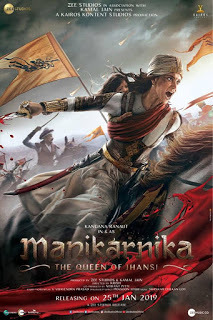 It is not a documentary, so do not expect factual accuracy. It is quite alright if you see the screen Jhansi Rani letting her hair down, getting into the groove and dancing with the villagers. At least they got the Mahishashura Mardini version of Queen Laxmibai right. Her unabated rage in fighting the tyranny of British can best be compared to the unstoppable fighting machine of Durga overpowering the Buffalo Demon of Mahishashura seen in the Mysore tradition. Living true to the feminine force of Nature which gives life and takes, Jhansi Rani has remained the Indian icon that spread nationalism and empowered women the world over, at least in the Indian diaspora.
It is not a documentary, so do not expect factual accuracy. It is quite alright if you see the screen Jhansi Rani letting her hair down, getting into the groove and dancing with the villagers. At least they got the Mahishashura Mardini version of Queen Laxmibai right. Her unabated rage in fighting the tyranny of British can best be compared to the unstoppable fighting machine of Durga overpowering the Buffalo Demon of Mahishashura seen in the Mysore tradition. Living true to the feminine force of Nature which gives life and takes, Jhansi Rani has remained the Indian icon that spread nationalism and empowered women the world over, at least in the Indian diaspora.
The 21st century has seen countries that used to be under the yoke of colonial powers in the previous centuries suddenly open their eyes to realise that their masters never left their shores. They had continued their grip on the newly developed economies through their web of deceit, control and mass hypnotism. Through remote control means with the aid of media, be it print or digital methods, via Hollywood and lately through social media and fake news platform, they are always one step ahead from the rest of the world. Hence, now more than ever, there is a need to rekindle the nationalistic spirit amongst the post-colonial population to combat these seemingly invisible tentacles that control our mind, money and soul.
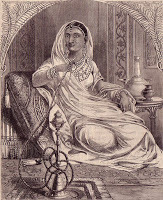 Died at 29; Immortalised by history.
Died at 29; Immortalised by history.
Laxmibai, Queen of Jhansi, born Manikarnika, was an impressive figure during the First Independence War of India also known the Sepoy Mutiny. She married the King of Jhansi when the East India Company was hot on their heels, expanding their territorial control by instigating feud amongst local princes and inciting political ambitions within the members of the royal courtyard. The Queen's 4 month-old infant mysteriously died and so did the King soon after. A relative's son was adopted for ascension to the throne later. This was deemed illegal by the British who had by then enacted 'Lapse Doctrine' where a territory without a proper heir became British control. Jhansi is given an annual allowance and is expelled from her palace.
She returned with a vengeance after careful planning. Her image of riding on horseback with her toddler tied to her back and brandishing a sword is immortalised on metal statues around India. Trying to defend the city Gwalior from the British Army, she succumbed to her wounds. Not wanting to be captured by an enemy she decided to indulge in self-immolation. Some accounts insist that she was just cremated after her death as per her instructions.
Even before the movie hit the theatres, it, or specifically its heroine, Kangana Ranaut, created a hype in the media. Perhaps it was intentional. As they say in showbiz, any news is good news to stir curiosity amongst its viewers. In an interview, she had apparently threatened to expose the Bollywood mafia on their stance on nepotism. Her directorial direction was also the topic of discussion in the media circle. Excellent at creating a mountain of a molehill, they made an issue when Ranaut apparently took the helm to finish off some loose ends on the final product. Sensationalism or not, Ranaut, a multiple award-winning actor, managed to pull the role of Jhansi Rani very well. This angry 32-year young woman managed to bring to the celluloid screen the story of a gutsy 22-year-old monarch who had the guts to say no to the technically advanced invaders and to give a run for their money.
Interestingly, the first battle against the British was fought jointly to the chant of ‘Bajrangi Bali’, ‘Ya Ali’ and ‘Har Har Mahadeva’. All occupants of the land who had been ever welcoming of sojourners raised in unison against the evil and greedy invaders who had nothing but plundering in their minds. The Indians, on the other hand, had thought of everything - philosophy, the art of living, symbiosis with Mature, arithmetic, space exploration and perhaps even black holes in space. Not the Black Holes of Calcutta that the invaders thought of to subjugate their subjects.
Funny how every time history is invoked, it is often construed as a nidus to start communal violence. It used to be a unifying factor.
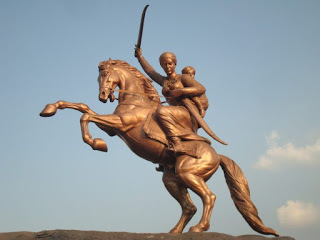 An equestrian statue of Lakshmibai in Solapur, Maharashtra.N.B. During World War 2, many young Malayan Indian women volunteered during Netaji Chandra Bose's recruitment drive to join Rani of Jhansi Women's Regiment of the Indian Army. It aimed to overthrow the British Raj with Japanese assistance. It was one of the very few all-female combat regiments of the Second World War on any side.
An equestrian statue of Lakshmibai in Solapur, Maharashtra.N.B. During World War 2, many young Malayan Indian women volunteered during Netaji Chandra Bose's recruitment drive to join Rani of Jhansi Women's Regiment of the Indian Army. It aimed to overthrow the British Raj with Japanese assistance. It was one of the very few all-female combat regiments of the Second World War on any side.

This work is licensed under a Creative Commons Attribution 4.0 International License.
http://asok22.wix.com/real-lesson
http://.facebook.com/farouk.gulsara
www.riflerangeboy.com
This work is licensed under a Creative Commons Attribution 4.0 International License.

 It is not a documentary, so do not expect factual accuracy. It is quite alright if you see the screen Jhansi Rani letting her hair down, getting into the groove and dancing with the villagers. At least they got the Mahishashura Mardini version of Queen Laxmibai right. Her unabated rage in fighting the tyranny of British can best be compared to the unstoppable fighting machine of Durga overpowering the Buffalo Demon of Mahishashura seen in the Mysore tradition. Living true to the feminine force of Nature which gives life and takes, Jhansi Rani has remained the Indian icon that spread nationalism and empowered women the world over, at least in the Indian diaspora.
It is not a documentary, so do not expect factual accuracy. It is quite alright if you see the screen Jhansi Rani letting her hair down, getting into the groove and dancing with the villagers. At least they got the Mahishashura Mardini version of Queen Laxmibai right. Her unabated rage in fighting the tyranny of British can best be compared to the unstoppable fighting machine of Durga overpowering the Buffalo Demon of Mahishashura seen in the Mysore tradition. Living true to the feminine force of Nature which gives life and takes, Jhansi Rani has remained the Indian icon that spread nationalism and empowered women the world over, at least in the Indian diaspora.The 21st century has seen countries that used to be under the yoke of colonial powers in the previous centuries suddenly open their eyes to realise that their masters never left their shores. They had continued their grip on the newly developed economies through their web of deceit, control and mass hypnotism. Through remote control means with the aid of media, be it print or digital methods, via Hollywood and lately through social media and fake news platform, they are always one step ahead from the rest of the world. Hence, now more than ever, there is a need to rekindle the nationalistic spirit amongst the post-colonial population to combat these seemingly invisible tentacles that control our mind, money and soul.
 Died at 29; Immortalised by history.
Died at 29; Immortalised by history.Laxmibai, Queen of Jhansi, born Manikarnika, was an impressive figure during the First Independence War of India also known the Sepoy Mutiny. She married the King of Jhansi when the East India Company was hot on their heels, expanding their territorial control by instigating feud amongst local princes and inciting political ambitions within the members of the royal courtyard. The Queen's 4 month-old infant mysteriously died and so did the King soon after. A relative's son was adopted for ascension to the throne later. This was deemed illegal by the British who had by then enacted 'Lapse Doctrine' where a territory without a proper heir became British control. Jhansi is given an annual allowance and is expelled from her palace.
She returned with a vengeance after careful planning. Her image of riding on horseback with her toddler tied to her back and brandishing a sword is immortalised on metal statues around India. Trying to defend the city Gwalior from the British Army, she succumbed to her wounds. Not wanting to be captured by an enemy she decided to indulge in self-immolation. Some accounts insist that she was just cremated after her death as per her instructions.
Even before the movie hit the theatres, it, or specifically its heroine, Kangana Ranaut, created a hype in the media. Perhaps it was intentional. As they say in showbiz, any news is good news to stir curiosity amongst its viewers. In an interview, she had apparently threatened to expose the Bollywood mafia on their stance on nepotism. Her directorial direction was also the topic of discussion in the media circle. Excellent at creating a mountain of a molehill, they made an issue when Ranaut apparently took the helm to finish off some loose ends on the final product. Sensationalism or not, Ranaut, a multiple award-winning actor, managed to pull the role of Jhansi Rani very well. This angry 32-year young woman managed to bring to the celluloid screen the story of a gutsy 22-year-old monarch who had the guts to say no to the technically advanced invaders and to give a run for their money.
Interestingly, the first battle against the British was fought jointly to the chant of ‘Bajrangi Bali’, ‘Ya Ali’ and ‘Har Har Mahadeva’. All occupants of the land who had been ever welcoming of sojourners raised in unison against the evil and greedy invaders who had nothing but plundering in their minds. The Indians, on the other hand, had thought of everything - philosophy, the art of living, symbiosis with Mature, arithmetic, space exploration and perhaps even black holes in space. Not the Black Holes of Calcutta that the invaders thought of to subjugate their subjects.
Funny how every time history is invoked, it is often construed as a nidus to start communal violence. It used to be a unifying factor.
 An equestrian statue of Lakshmibai in Solapur, Maharashtra.N.B. During World War 2, many young Malayan Indian women volunteered during Netaji Chandra Bose's recruitment drive to join Rani of Jhansi Women's Regiment of the Indian Army. It aimed to overthrow the British Raj with Japanese assistance. It was one of the very few all-female combat regiments of the Second World War on any side.
An equestrian statue of Lakshmibai in Solapur, Maharashtra.N.B. During World War 2, many young Malayan Indian women volunteered during Netaji Chandra Bose's recruitment drive to join Rani of Jhansi Women's Regiment of the Indian Army. It aimed to overthrow the British Raj with Japanese assistance. It was one of the very few all-female combat regiments of the Second World War on any side.
This work is licensed under a Creative Commons Attribution 4.0 International License.
http://asok22.wix.com/real-lesson
http://.facebook.com/farouk.gulsara
www.riflerangeboy.com
This work is licensed under a Creative Commons Attribution 4.0 International License.

Published on May 11, 2019 02:00
May 8, 2019
It is not a bed time story!
Sampoorna Ramayanam (Complete Ramayana, Tamil;1956)
(சம்பூர்ண ராமாயணம்)

The epic of Ramayana has fascinated people for ages. It has been narrated for generations via oral traditions, print media, stage performances and the silver screen. As early as 1922, a silent film on Ramayana came out in cinemas. Before this 1956 Tamil version, Hindi and Telegu versions of Ramayana can be found. Many other editions since then, and now, at the time of cable TV, Ramayana has permeated into households regularly.
There are many versions of Ramayana. Valmiki wrote the earliest one. Even Hanuman was concurrently writing his view on the occurrences of the day. With time, it evolved to Buddhist, Jain and South East Asian adaptations.
Valmiki's Ramayana is said to be the authentic text of Rama's life, but it ends with his coronation at the throne after his banishment to the jungles for 14 years and capturing Sita from Ravana. Other additions of vilification of Ravana as the classical evil bad guy and exile of a pregnant Sita after overhearing the murmur of a washerman remains folklore at best. Scholars who analysed these Sanskrit scripts agree that these were written in a slightly less refined language.
Sivaji Ganesan had already established himself as a reputable artiste by then, but due to his spirited way of acting, he was naturally not cast as Rama. Lord Rama, an avatar of Vishnu, the pillar of stoicism was played by the sombre, perhaps apathetic NT Rama Rao who later went on to have a very successful career in politics. Maybe, his casting in divine roles made the general public see him in a different light.
The first part of the film was very slow moving with most of the storytelling done through songs. This was the old way of economising time, to give value for money. The actor cast as Kaikeyi, the second wife of King Dasaratha, played a convincing role as a jealous mother worried about her position after her biological son is sidelined for the throne. She transforms well from a loving stepmother to Rama to a witch after being influenced by her foster mother.
Generally, people do not name their daughters Kaikeyi as she is perceived as the earliest villain of Ramayana. If not for her, demanding for her boons from the King, the whole hullabaloo of Rama going to the woods and the fight with Lanka would not have arisen. Lately, there is a reinterpretation of Kaikeyi's role in the whole saga. Her character was vital in Rama's development into a figure than himself. His dharma was plentiful in the jungle. There were many boons and work to be done there; not cooped in Ayuthia and rule a kingdom. For good things to happen, we need a jolt on the status quo. King Dasaratha is described as a smothering father who arrested Rama's development!
A cursory knowledge of Ramayana is mandatory to appreciate this movie.
As expected Sivaji who assumes the role of Barathan is at ease to display a melodramatic portrayal of a very loving brother of hearing that his thoughtful brother had been dethroned and banished. He rejuvenates the later part of the show with his presence.
Unlike the sermons in temples where Ravana is portrayed as a ten-headed fiery hot asura, in this movie, he is shown as a very decent human monarch. He is learned and is kind to all his family members, the royal court staff and his subjects. It is his sister, Shurpanakha, who fanned the fire of fury. It is his love of his sister that clouded his judgment. He went ahead to kidnap Sita. This was atypical of him; a scholar of many arts and sciences kidnapping somebody else's wife.
The film illustrates the turmoil that he goes through as he takes stock of his situation on the eve of his defeat. He regrets the destruction of his kingdom, the pain caused and the dilemma of whether to conceit defeat or to end his life in shame. To fight was sure failure but to commit suicide was cowardice. Bhagavathi plays the role of Ravana.
The song 'Indru Poi Naalai Vaarai' (Go today, Come tomorrow) is rendered in the film by C. S. Jayaraman. Here, Bhagavathi, playing Ravana, is in a dilemma. It was a day before the final kill. Ravana, having lost his army, meets eye-to-eye with Rama. Instead of giving the coup de grace, Rama tells him to go and return to fight the next day. This song has become an immortal melody. Composed in 'Thilang' raaga, an import from Sufi music, this song was successfully adapted by Guru Nanak and his disciples who composed several hymns. It was extremely popular with musical geniuses like Ravishankar, Bhimsen Joshi, violin maestro Lalgudi Jayaraman and musicologist G. S. Mani. The great Carnatic musician D. K. Pattammal recorded a song, ‘Shanthi Nilava Vendum,’ in this raaga on the occasion of the shocking death of Mahatma Gandhi in 1948.

This work is licensed under a Creative Commons Attribution 4.0 International License.
http://asok22.wix.com/real-lesson
http://.facebook.com/farouk.gulsara
www.riflerangeboy.com
This work is licensed under a Creative Commons Attribution 4.0 International License.

(சம்பூர்ண ராமாயணம்)

The epic of Ramayana has fascinated people for ages. It has been narrated for generations via oral traditions, print media, stage performances and the silver screen. As early as 1922, a silent film on Ramayana came out in cinemas. Before this 1956 Tamil version, Hindi and Telegu versions of Ramayana can be found. Many other editions since then, and now, at the time of cable TV, Ramayana has permeated into households regularly.
There are many versions of Ramayana. Valmiki wrote the earliest one. Even Hanuman was concurrently writing his view on the occurrences of the day. With time, it evolved to Buddhist, Jain and South East Asian adaptations.
Valmiki's Ramayana is said to be the authentic text of Rama's life, but it ends with his coronation at the throne after his banishment to the jungles for 14 years and capturing Sita from Ravana. Other additions of vilification of Ravana as the classical evil bad guy and exile of a pregnant Sita after overhearing the murmur of a washerman remains folklore at best. Scholars who analysed these Sanskrit scripts agree that these were written in a slightly less refined language.
Sivaji Ganesan had already established himself as a reputable artiste by then, but due to his spirited way of acting, he was naturally not cast as Rama. Lord Rama, an avatar of Vishnu, the pillar of stoicism was played by the sombre, perhaps apathetic NT Rama Rao who later went on to have a very successful career in politics. Maybe, his casting in divine roles made the general public see him in a different light.
The first part of the film was very slow moving with most of the storytelling done through songs. This was the old way of economising time, to give value for money. The actor cast as Kaikeyi, the second wife of King Dasaratha, played a convincing role as a jealous mother worried about her position after her biological son is sidelined for the throne. She transforms well from a loving stepmother to Rama to a witch after being influenced by her foster mother.
Generally, people do not name their daughters Kaikeyi as she is perceived as the earliest villain of Ramayana. If not for her, demanding for her boons from the King, the whole hullabaloo of Rama going to the woods and the fight with Lanka would not have arisen. Lately, there is a reinterpretation of Kaikeyi's role in the whole saga. Her character was vital in Rama's development into a figure than himself. His dharma was plentiful in the jungle. There were many boons and work to be done there; not cooped in Ayuthia and rule a kingdom. For good things to happen, we need a jolt on the status quo. King Dasaratha is described as a smothering father who arrested Rama's development!
A cursory knowledge of Ramayana is mandatory to appreciate this movie.
As expected Sivaji who assumes the role of Barathan is at ease to display a melodramatic portrayal of a very loving brother of hearing that his thoughtful brother had been dethroned and banished. He rejuvenates the later part of the show with his presence.
Unlike the sermons in temples where Ravana is portrayed as a ten-headed fiery hot asura, in this movie, he is shown as a very decent human monarch. He is learned and is kind to all his family members, the royal court staff and his subjects. It is his sister, Shurpanakha, who fanned the fire of fury. It is his love of his sister that clouded his judgment. He went ahead to kidnap Sita. This was atypical of him; a scholar of many arts and sciences kidnapping somebody else's wife.
The film illustrates the turmoil that he goes through as he takes stock of his situation on the eve of his defeat. He regrets the destruction of his kingdom, the pain caused and the dilemma of whether to conceit defeat or to end his life in shame. To fight was sure failure but to commit suicide was cowardice. Bhagavathi plays the role of Ravana.
The song 'Indru Poi Naalai Vaarai' (Go today, Come tomorrow) is rendered in the film by C. S. Jayaraman. Here, Bhagavathi, playing Ravana, is in a dilemma. It was a day before the final kill. Ravana, having lost his army, meets eye-to-eye with Rama. Instead of giving the coup de grace, Rama tells him to go and return to fight the next day. This song has become an immortal melody. Composed in 'Thilang' raaga, an import from Sufi music, this song was successfully adapted by Guru Nanak and his disciples who composed several hymns. It was extremely popular with musical geniuses like Ravishankar, Bhimsen Joshi, violin maestro Lalgudi Jayaraman and musicologist G. S. Mani. The great Carnatic musician D. K. Pattammal recorded a song, ‘Shanthi Nilava Vendum,’ in this raaga on the occasion of the shocking death of Mahatma Gandhi in 1948.

This work is licensed under a Creative Commons Attribution 4.0 International License.
http://asok22.wix.com/real-lesson
http://.facebook.com/farouk.gulsara
www.riflerangeboy.com
This work is licensed under a Creative Commons Attribution 4.0 International License.

Published on May 08, 2019 09:11
May 5, 2019
Nothing wrong?
 Tunku and Think Big, Melbourne Cup winner, 1975.I remember a time when I was a pre-schooler. In front of the family black-and-white TV, I got all excited when a horse appeared on the screen. Maybe they were screening Mr Ed, the talking horse or something like that. I must have said something to the effect of, "I saw many horses the other day. Appa took me there!" looking directly at Amma. That is when the fight started.
Tunku and Think Big, Melbourne Cup winner, 1975.I remember a time when I was a pre-schooler. In front of the family black-and-white TV, I got all excited when a horse appeared on the screen. Maybe they were screening Mr Ed, the talking horse or something like that. I must have said something to the effect of, "I saw many horses the other day. Appa took me there!" looking directly at Amma. That is when the fight started.True. There was a time when Appa used to frequent the racing turf club for little thrills and pennies. I was brought there, only once, I presume, before I spilt the beans.
Naturally, over the years I became convinced that horse racing is terrible and the negative association with betting. Slowly, one by one, as in an all-or-none, everything was laid upon me. The first drop of alcohol would turn you into a raging alcoholic. One deep breath of nicotine would damage your lungs irreparably. At the tender age when all of one's focus should be on securing a sound education, there is no place for romance, so I was told.
Then the others told me that there was nothing wrong in racing horses. Even the Prime Minister owned a horse that won the Melbourne Cup. Students were treated to free tickets of screening of 'National Velvet' starring Elizabeth Taylor for Merdeka. It was a tale of former jockey helping a young girl prepare a wild but gifted horse for England's Grand National Sweepstakes; like it was alright to compete in horse racing and winning the lottery.
Then the local television tried to say that drinking Guinness Stout, a strong brew, was good for you. After a hard day's work, one deserves a Stout. The boisterous men at the local toddy shop that I saw on my way back from school did not testify to that.
The TV also told us, young kids, that when you are out of inspiration, grab a stick of John Player Classic cigarette from Pall Mall. Ideas will ooze copiously, and before long the unfinished portrait will turn out to be a prized possession.
Slowly, the media started showing teenager themed movies where teenage boys are expected to develop feelings for the opposite sex even though they are barely able to support themselves, what more handling a relationship and the by-product of the biological process of an adult. Still, they said, there is nothing wrong. It is normal.
It is normal to be frequenting races, betting, indulging in intoxicants, pre-marital sexual liaisons and even teenage involvement in adult or illicit activities. One develops character, they said.
Slowly everything became acceptable. It was alright to bend the rules to accommodate mediocrity. Failure was not rebuked but rewarded. You do not need a couple to be opposite genders to unite in holy matrimony. Neither do they need a father and mother unit to raise a child? And they wonder what went wrong?
https://asok22.wixsite.com/real-lesson

This work is licensed under a Creative Commons Attribution 4.0 International License.
http://asok22.wix.com/real-lesson
http://.facebook.com/farouk.gulsara
www.riflerangeboy.com
This work is licensed under a Creative Commons Attribution 4.0 International License.

Published on May 05, 2019 09:45
May 3, 2019
History just a convenient distraction?
 Kalank (Hindi, Stigma; 2019)
Kalank (Hindi, Stigma; 2019)
I agreed to go and watch this movie as I was told it was a period drama, set at the most tumultuous time in the history of India, around the Partition. I was looking forward to seeing all the excitement and the political wrangling that surrounded the amputation of arms that held Mother India together. Sadly, what it turned out to be was a lovey-dovey soap opera instead. Typical of mini-serials that fill our airspace, the film delved in annoyingly artificial slow motion shots that accentuate nothings but highlights the ridiculousness of the plots, drags the performance to over two and a half hours and drives home the point that it is just a meaningless soap opera with massive sets and flashy costumes.
The cinematography is quite breathtaking but what is the point if it is not complemented with a believable plot and relevant crisis? The landscape is definitely whitewashed, CGI perhaps. True, Indian history boasts of fearless female sorceresses and erudite women poets, marriage, love and sex remain a taboo. Definitely, it would have been so in the mid-1940s, the time the film was set. Imagine a 20-something young woman fighting for her sexual freedom at the time when even the country had no independence from the tyranny of the British.
 The story tells the sad tale of a boisterous young girl, Roop, trapped into marriage due to poverty. The husband, Dev, is a reluctant participant of this arrangement as his current wife, Satya, is still alive but has only a year to live due to an unspecified medical ailment. Roop was picked out by the ailing wife, Satya, as a sort of a mistress but Roop wanted assurance, hence the union.
The story tells the sad tale of a boisterous young girl, Roop, trapped into marriage due to poverty. The husband, Dev, is a reluctant participant of this arrangement as his current wife, Satya, is still alive but has only a year to live due to an unspecified medical ailment. Roop was picked out by the ailing wife, Satya, as a sort of a mistress but Roop wanted assurance, hence the union.The family that Roop goes into is tainted. Theirs is a wealthy Hindu family who runs the local daily in a town predominantly filled with poor Muslims. Partition talk is hotly debated. There are rumours of British industries eating into the town, Hasnabad's livelihood. The city, known for its blacksmiths from time immemorial, has to probably close shop, squashed by the mega industries. The townsfolks are up in arms for the papers do not highlight their predicament.
Roop meets her dream lover, Zafar, but the lover is using her as a vendetta against Dev and his family. Zafar is Dev's half-brother, the result of Dev's father affair with the local courtesan, Bahaar Begum. Zafar grew up abandoned as both his parent refuse admission to paternity. And the ember of animosity between the 'remainers' and 'exiteers' of Bharat Desh sizzles on. Interestingly, the theme of the movie is love and finding the right love. It has nothing to do with Partition. It is just a distraction. Nothing was mentioned in the film about inter-communal love or the build-up to the communal violence that climaxes towards the end of the movie. The computer graphics appear unconvincing. Thumbs down.

This work is licensed under a Creative Commons Attribution 4.0 International License.
http://asok22.wix.com/real-lesson
http://.facebook.com/farouk.gulsara
www.riflerangeboy.com
This work is licensed under a Creative Commons Attribution 4.0 International License.

Published on May 03, 2019 15:18
May 1, 2019
The leaders and the led...
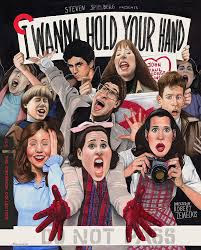 I wanna hold your hand (1978)
I wanna hold your hand (1978)
Director: Robert Zemeckis (debut)
I remember growing up watching many of Zemeckis directed movies. So, I was pleasantly surprised when I came across this film which was set in 1964 New York when the Beatles visited New York to appear at the Ed Sullivan's Show.
At one look, it appears like the director is trying to recreate the atmosphere and the mania associated with the arrival of the Liverpool lads at the Big Apple. Looking at the bigger picture, he seems to be ridiculing the younger generation's eccentricity, if not fetishism to pop culture.
It tells the tale of a group of youngsters who make a trip to New York to catch a glimpse of the Fab Four. Each of them has a different agenda; to watch the Ed Sullivan Show, to snap pictures of Beatles, to partake in anti-Beatles' rally, to impress a girl and so on.
In no way was the film a groundbreaking feat. All you throughout the offering are screaming and shrieking bevvy of girls before and during the Beatles' show. Even though the setting is supposed to the mid-sixties, one cannot help but have an 80s feel to throughout the film.
It is interesting how the storyteller managed to make a movie about the Beatles without actually making them appear on the screen. The 'appearances' are restricted to their 'voices' in the background and their songs.
We are all so easily suggestible. We are easily swayed by the consensus of the masses. Some of us are spineless. We walk around like zombies following the scent of the herd. Sometimes, our senses get all entangled. We cannot comprehend whether our likes are related to our nostalgia, our simple cravings for the unattainable, our biological need or is a way to satisfy our sexual pervasions. Our fetish is further fanned by the wind of mass media and commercialisation. Every day a new 'want' is created. And many lose sleep to achieve it. At least it gives them something to forward to in their otherwise mundane life. They have overcome many major hurdles establishing themselves as the ruler of the world that they are trying to find the fine prints to perfect it. Paradoxically, it only brings them down. Or maybe, it has always been like this - the victors or elitists writing and re-writing the course of history whilst the weak majority just trail along, sometimes paying with their lives.
https://asok22.wixsite.com/real-lesson

This work is licensed under a Creative Commons Attribution 4.0 International License.
http://asok22.wix.com/real-lesson
http://.facebook.com/farouk.gulsara
www.riflerangeboy.com
This work is licensed under a Creative Commons Attribution 4.0 International License.

Published on May 01, 2019 09:30
April 29, 2019
The joy of Tamil songs
Yeats, Keats and TS Elliot all wrote fantastic poems. Rumi did the same but at a different level. To connoisseurs of Tamil poems, they transcend all boundaries. A poet can describe his loved ones in so many words, compare her to lush of Mother Nature or the beauty of a full moon but a Tamil poet describes her at a divine level. Something as mundane as feeling frisky on a wet evening is pictured by Vairamuthu beautifully in a single stanza. (From the 1980s movie 'Raja Parvai' where ironically a blind man describes his feeling to his non-blind companion)
We have heard songs that induce suicide. The Hungarian composer Rezsö Seress is given the dubious honour of composing the song, Gloomy Sunday, in 1932, that is connected to more suicides than any song in history. A Tamil song, Mayakkama Thayakkama from the movie 'Sumathanggi' carries the honour of saving one of Tamil cinema's great music composer from the clutches of suicide. MSV was in doldrums and was contemplating death. His last wish was to die listening to Tamil music. The song that was playing on the radio was the above and one particular line struck him. He abandoned his attempt at ending his life and went living a productive life until the ripe age of 85. That particular line is below. It is written to illustrate the turmoil that the lead character was going through as his family commitments pushed him to misappropriate funds at the bank he worked.
These are some of the pearls of wisdom that the attendees learnt at a recent gathering to appreciate old Tamil cinema songs. A group of close to 80 people comprising Generation-X and Baby Boomer Generation, all with a common interest in songs from the golden era of Tamil cinema which is obviously between the 1950s all through to the 1970s, gathered at a hall in Kuala Lumpur recently. Accompanied by three singers, a musician and a music machine, the organisers managed to cradle the audience to an era when life was easy, love was private, personal intentions were implied and politicians were honest.
Interspersed through this 3-hour musical extravaganza was a discourse on musical appreciation, musical game (a sort of Tamil Antakshari) and a mimicry presentation. Antakshari, an ancient spoken parlour game that is mentioned to have been played by sages even as early as the Ramayana era, involves two groups and their ability to start singing songs with the last word of the song that their opponent ends.
All in all, it was a Sunday evening well spent, for most of the attendees, who were mostly in the sixties and seventies, a time to reminisce a moment when they were in the spring of their youth and the whole wide world was at their taking. With it must have been bitter instances but music numbs the pain. The poetic and thought-provoking lines of Tamil songs do it better. It heals.

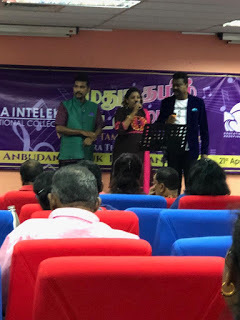
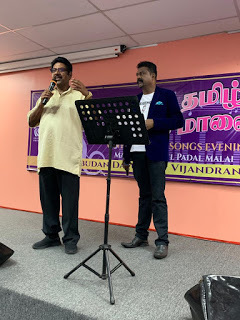


This work is licensed under a Creative Commons Attribution 4.0 International License.
http://asok22.wix.com/real-lesson
http://.facebook.com/farouk.gulsara
www.riflerangeboy.com
This work is licensed under a Creative Commons Attribution 4.0 International License.

"அந்தி மழை பொழிகிறது,
ஒவொவரு தூளியிலும் உன் முகம் தெரிகிறது"
'Evening rain is pouring,Some may call these lyrics cheesy but it works perfectly well for admirers of Tamil literature.
In its every droplet, I see your face.
We have heard songs that induce suicide. The Hungarian composer Rezsö Seress is given the dubious honour of composing the song, Gloomy Sunday, in 1932, that is connected to more suicides than any song in history. A Tamil song, Mayakkama Thayakkama from the movie 'Sumathanggi' carries the honour of saving one of Tamil cinema's great music composer from the clutches of suicide. MSV was in doldrums and was contemplating death. His last wish was to die listening to Tamil music. The song that was playing on the radio was the above and one particular line struck him. He abandoned his attempt at ending his life and went living a productive life until the ripe age of 85. That particular line is below. It is written to illustrate the turmoil that the lead character was going through as his family commitments pushed him to misappropriate funds at the bank he worked.
ஏழை மனதை மாளிகையாகி இரவும் பகலும் கவியைம் பாடி நாளை பொழுதை இறைவனுக்களித்து கொடுத்து நடக்கும் வாழ்க்கையில் அமைதியத் தேடுSomewhat striking a chord with his line of work - composing songs for the entertainment of others, MSV thought the song was speaking to him to stop his nonsensical action.
Building castle in the heart of the poor,The above lyrics can be found in the Youtube clip below. The tail end of the song 'Mayakkama Thayakkama' (Queasy or reluctance?) from the movie 'Sumaithaangi' (One who carries the burden) tells the dilemma of a wage earner whose conscience haunts him after he, as a bank teller, had falsified a signature to draw money to meet pressing familial engagements.
Day and night reciting poetry,
Giving tomorrow to God,
Find peace in the life ahead...
These are some of the pearls of wisdom that the attendees learnt at a recent gathering to appreciate old Tamil cinema songs. A group of close to 80 people comprising Generation-X and Baby Boomer Generation, all with a common interest in songs from the golden era of Tamil cinema which is obviously between the 1950s all through to the 1970s, gathered at a hall in Kuala Lumpur recently. Accompanied by three singers, a musician and a music machine, the organisers managed to cradle the audience to an era when life was easy, love was private, personal intentions were implied and politicians were honest.
Interspersed through this 3-hour musical extravaganza was a discourse on musical appreciation, musical game (a sort of Tamil Antakshari) and a mimicry presentation. Antakshari, an ancient spoken parlour game that is mentioned to have been played by sages even as early as the Ramayana era, involves two groups and their ability to start singing songs with the last word of the song that their opponent ends.
All in all, it was a Sunday evening well spent, for most of the attendees, who were mostly in the sixties and seventies, a time to reminisce a moment when they were in the spring of their youth and the whole wide world was at their taking. With it must have been bitter instances but music numbs the pain. The poetic and thought-provoking lines of Tamil songs do it better. It heals.





This work is licensed under a Creative Commons Attribution 4.0 International License.
http://asok22.wix.com/real-lesson
http://.facebook.com/farouk.gulsara
www.riflerangeboy.com
This work is licensed under a Creative Commons Attribution 4.0 International License.

Published on April 29, 2019 09:01
April 27, 2019
Fight fire with fire?
 Avengers: Endgame (2019)
Avengers: Endgame (2019)
We always associate destruction with negativity. Erection and construction, on the other hand, is hailed as the epitome of prosperity. Hence, annihilation, collision and termination are scorned upon. Unfortunately, life is not so simple. There can never be peace without prior anarchy; no construction without demolition and no shanthi without ashanti. Life, with its ups and down, are aplenty with cyclical loss and gains.
That was the same dilemma when I came to discover about Lord Shiva, one of the main component of the Trinity in the post-Vedic Hinduism. The trident-bearing Lord is revered for his greatness and ferocious power to destroy and is invoked for peace on Earth. It baffled me how damage can lead to prosperity. Herein lies the profound philosophy of life. Someone or something who jolts the equilibrium, the status quo, has to or to be destroyed before life can proceed in a just manner. The evils do not necessarily come from without to spew negativity. It could be within; an ill-thought good intention, a self-serving need, blinded vision of what is right and the list goes on. We need to kill the roaches to take control of our house. The roaches do not know that they are doing any wrong. They are just performing the tasks they were programmed to - to find territory, food, procreate and ensure continuity of species. Their biological mission is only a hindrance to us, not them. In their compound eyes, they are doing the right thing. We, from our perspective, spring at them with fear of disease, filth and loss of territory. Probably dominance too as we know cockroaches can resist a nuclear meltdown.
 Thanos with his Infinity Gauntlet.
Thanos with his Infinity Gauntlet.
Like Shiva, is a destroyer. Vapourised up to half
of the population of the Universe.
If the population explosion is leaving a long
and an ugly trail of carbon footprint, then
Thanos' actions should be lauded.We always think that colonisation, wars and enslavement are only found in the confines of our history book. The truth is far from that. Even though we are living in an era where education and knowledge had never been so freely available, we are all far from wise. Forget Nazi Hitler and Pol Pot. Even in the 21st century, we have people like George Soros and the Cabal who are hellbent on destroying societies. Soros, the leading globalist is still actively trying to re-organise the community which has evolved itself into a steady state. It looks like he will not stop till anarchy prevails. The Cabal, with its web of destruction, spreading through the world over with the cooperation of the Bank of London and fellow similar minded magnates, have been linked to many well planned and well-executed significant tragedies. There is a concerted effort to destroy the sovereignty of nations, open borders, restructuring societies and make communities godless.
One wonders whether Gandhi's passive resistance would save the day. Do we fight fire with fire, douse with water or practice self-immolation?
To enjoy Avengers: Endgame, one has to have a little background that brought the whole Marvel Cinematic Universe into turmoil. Thanos, the unstoppable destroyer, has in possession the six Infinity Stones (that controls time, space, mind, reality, soul and power) and had sent many of the superheroes into cold storage. With a little push from Carol Danvers (Captain Marvel), the ingenious mind of Iron Man, time travel, Hulk's scientific know-how and a lot of kissass action from the Marvel heroes, sanity prevails.
To the uninitiated, without a background of the various characters, the film would appear a tad confusing. With so many different heroes with different suits swerving past the villain throwing ammunitions of different hues and explosive potentials, everything would seem like a fiesta of pyrotechnic display. Then, one would be wondering who those cute animals and weird looking ladies are and how they get pulled into the melee.
The movie also gives the millennials a crash course in time travel, just like what Back to the Future did for the Generation-X in the 80s. Time travel comes with it its own benefits and peculiarities.
In war, everybody loses, but the winner takes all, whatever is left. In the war to end all evils, the protagonist also faced heavy casualties. You have to watch to find out. The audience goes back with a sombre feeling that this outing could be the last for the Avengers. Bearing in mind that the MCU is a make-believe one, anything is possible, especially when the fans (a.k.a. suckers) feel nostalgic and the filmmakers feel a need to fill their coffers.
Talking about fans, while watching the movie, as and when various superheroes appeared on screen or landed a blow Thanos, I had a certain feeling I am watching a Tamil movie. The viewers were upstanding cheering and even giving hearty laughs to the tongue-in-cheek dialogues uttered by the characters. This is a new experience in Malaysia. The usual cinema going crowd here pay to see bigger-than-life explosions, gore and flesh, not dialogue. And to top it, a large portion of the audience was reluctant to exit the hall even after the credit finished rolling out. As if the 3-hour long movie was not long enough! I later found out some even wept at the ending when.. (oops, no spoiler alert!)
Avengers: Watch This Before You See Endgame
https://asok22.wixsite.com/real-lesson

This work is licensed under a Creative Commons Attribution 4.0 International License.
http://asok22.wix.com/real-lesson
http://.facebook.com/farouk.gulsara
www.riflerangeboy.com
This work is licensed under a Creative Commons Attribution 4.0 International License.

Published on April 27, 2019 19:33
April 25, 2019
Symbolism galore!
Us (2019)
Written and Directed: Jordan Peele
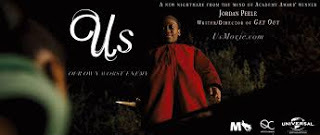
We think that we deserve the life we are leading, that everybody else there is to serve us, that the Universe owes us a living. We live under a false assumption that we merit the comforts and luxuries that are showered upon us. We demand that the little people be subservient to us. "You know who I am?" we tell them.
It only takes a single catastrophe to turn the tables. When the balance is tipped, when equilibrium is tilted because of man-made or natural catastrophe, pandemonium would rule. There would be no niceties. The hierarchical order of the societies would crumble. The Master-Servant role would be reversed. For survival, one has fight tooth and nail.
In my opinion, the above message is subtly conveyed in Jordan Peele's latest blockbuster 'Us'. At the word go, it is staring right at our face. The symbolism in this movie can only be rivalled by Dan Brown's 'Da Vinci Code'. 'Us' may imply that the story is the US, the country! The word 'us' of late has been used as a confrontational tool - us, the citizens of the greatest country of the world versus the rest of the sub-human countries of the world; either you are with us or against us etcetera. The people who the USA had wronged over the years, like their interference on the affairs of the Central and the South American countries, are arriving in convoys and banging at their doorsteps, screaming to come in. And the established US citizens are not willing to part with their share of the American pie.
 'Us' the movie also tries to incorporate many established urban legends. There is a mention of a secret Government project to clone people to aid in their nefarious activities. Somehow the project failed miserably and the doppelgangers were screaming to reclaim their lives as the other. The only successful part of the project is the tunnels that all under the USA.
'Us' the movie also tries to incorporate many established urban legends. There is a mention of a secret Government project to clone people to aid in their nefarious activities. Somehow the project failed miserably and the doppelgangers were screaming to reclaim their lives as the other. The only successful part of the project is the tunnels that all under the USA.
That brings us to the frequent mention of 1986 campaign 'Hands across America', the time when the lead character goes missing in a funfair and swaps places with her cloned double. This initiative was run along the lines of 'USA for Africa' - to collect money from well-meaning and well-to-do Americans to help the needy. Even though it is humanly impossible to join hands across America coast to coast, bearing in mind the terrain of the continent, the organisers made everyone believe that it was possible. In the film, unlike the people above, who could not complete the human chain, the 'Tethered People' (the products of the clone) had a complete tunnel beneath. It goes to show our insincerity in helping people. We create an illusion of prosperity when in actuality we are not. We think we are happy but we have to pacify ourselves in alcohol, rubbing shoulders with the rich and famous, immersed in the culture of over-consumption and addicted to our hand-held devices to fool ourselves into believing that we are indeed happy.
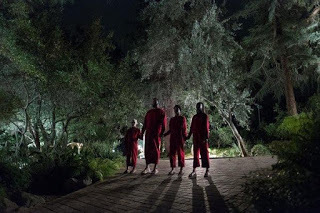 Fake too is the 'Hands Across America' project. It failed to reach its target but only raised the stardom of the personalities involved. The 'haves' only seems to show that they empathised the 'have nots' and have them in their heart and mind. In reality, it is just lip service. They want them to stay at the impoverished levels. They do not want them to have equal footing with the rest.
Fake too is the 'Hands Across America' project. It failed to reach its target but only raised the stardom of the personalities involved. The 'haves' only seems to show that they empathised the 'have nots' and have them in their heart and mind. In reality, it is just lip service. They want them to stay at the impoverished levels. They do not want them to have equal footing with the rest.
The oppressed or the underprivileged will rise. When that happens, in short, nothing can stop. There is a frequent reference to a biblical passage, Jeremiah 11.11, in the film. It forecasts a bleak future for the surface dwellers, for they shall not able to escape despite their pleas to God. It was referenced to God wrath to idol worshippers in Babylon.
In short, it was an interesting movie. Forget the horror genre attached to it. It would be more fun knowing that there are more than meets the eye. Having a background of the symbolism appearing in the flick makes it doubly captivating.

This work is licensed under a Creative Commons Attribution 4.0 International License.
http://asok22.wix.com/real-lesson
http://.facebook.com/farouk.gulsara
www.riflerangeboy.com
This work is licensed under a Creative Commons Attribution 4.0 International License.

Written and Directed: Jordan Peele

We think that we deserve the life we are leading, that everybody else there is to serve us, that the Universe owes us a living. We live under a false assumption that we merit the comforts and luxuries that are showered upon us. We demand that the little people be subservient to us. "You know who I am?" we tell them.
It only takes a single catastrophe to turn the tables. When the balance is tipped, when equilibrium is tilted because of man-made or natural catastrophe, pandemonium would rule. There would be no niceties. The hierarchical order of the societies would crumble. The Master-Servant role would be reversed. For survival, one has fight tooth and nail.
In my opinion, the above message is subtly conveyed in Jordan Peele's latest blockbuster 'Us'. At the word go, it is staring right at our face. The symbolism in this movie can only be rivalled by Dan Brown's 'Da Vinci Code'. 'Us' may imply that the story is the US, the country! The word 'us' of late has been used as a confrontational tool - us, the citizens of the greatest country of the world versus the rest of the sub-human countries of the world; either you are with us or against us etcetera. The people who the USA had wronged over the years, like their interference on the affairs of the Central and the South American countries, are arriving in convoys and banging at their doorsteps, screaming to come in. And the established US citizens are not willing to part with their share of the American pie.
 'Us' the movie also tries to incorporate many established urban legends. There is a mention of a secret Government project to clone people to aid in their nefarious activities. Somehow the project failed miserably and the doppelgangers were screaming to reclaim their lives as the other. The only successful part of the project is the tunnels that all under the USA.
'Us' the movie also tries to incorporate many established urban legends. There is a mention of a secret Government project to clone people to aid in their nefarious activities. Somehow the project failed miserably and the doppelgangers were screaming to reclaim their lives as the other. The only successful part of the project is the tunnels that all under the USA.That brings us to the frequent mention of 1986 campaign 'Hands across America', the time when the lead character goes missing in a funfair and swaps places with her cloned double. This initiative was run along the lines of 'USA for Africa' - to collect money from well-meaning and well-to-do Americans to help the needy. Even though it is humanly impossible to join hands across America coast to coast, bearing in mind the terrain of the continent, the organisers made everyone believe that it was possible. In the film, unlike the people above, who could not complete the human chain, the 'Tethered People' (the products of the clone) had a complete tunnel beneath. It goes to show our insincerity in helping people. We create an illusion of prosperity when in actuality we are not. We think we are happy but we have to pacify ourselves in alcohol, rubbing shoulders with the rich and famous, immersed in the culture of over-consumption and addicted to our hand-held devices to fool ourselves into believing that we are indeed happy.
 Fake too is the 'Hands Across America' project. It failed to reach its target but only raised the stardom of the personalities involved. The 'haves' only seems to show that they empathised the 'have nots' and have them in their heart and mind. In reality, it is just lip service. They want them to stay at the impoverished levels. They do not want them to have equal footing with the rest.
Fake too is the 'Hands Across America' project. It failed to reach its target but only raised the stardom of the personalities involved. The 'haves' only seems to show that they empathised the 'have nots' and have them in their heart and mind. In reality, it is just lip service. They want them to stay at the impoverished levels. They do not want them to have equal footing with the rest. The oppressed or the underprivileged will rise. When that happens, in short, nothing can stop. There is a frequent reference to a biblical passage, Jeremiah 11.11, in the film. It forecasts a bleak future for the surface dwellers, for they shall not able to escape despite their pleas to God. It was referenced to God wrath to idol worshippers in Babylon.
In short, it was an interesting movie. Forget the horror genre attached to it. It would be more fun knowing that there are more than meets the eye. Having a background of the symbolism appearing in the flick makes it doubly captivating.

This work is licensed under a Creative Commons Attribution 4.0 International License.
http://asok22.wix.com/real-lesson
http://.facebook.com/farouk.gulsara
www.riflerangeboy.com
This work is licensed under a Creative Commons Attribution 4.0 International License.

Published on April 25, 2019 09:01



